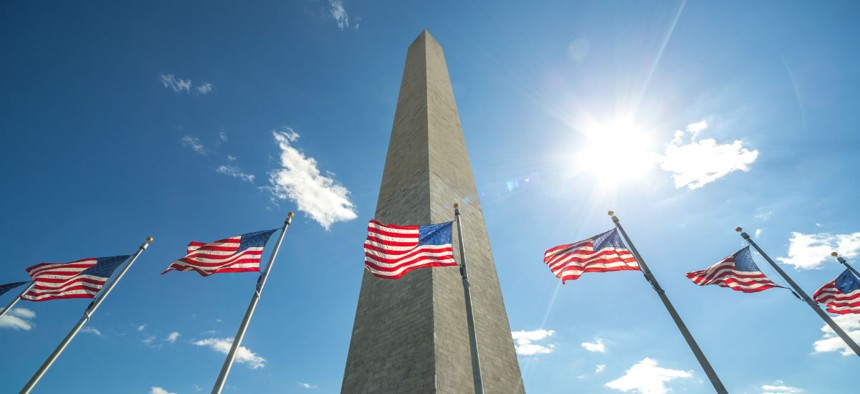Lawmaker: New Congress Is 'A Moment to Reimagine the Federal Government'
Rep. Cathy McMorris Rodgers, R-Wash., uses a new twist on the "Washington Monument" strategy.
For decades, political players have invoked the so-called “Washington Monument” strategy of threatening to close the capital city’s tallest structure to win a budget battle.
This Wednesday, Rep. Cathy McMorris Rodgers, R-Wash., head of the Republican conference, offered a new twist on the strategy as she appeared with Vice President-elect Mike Pence to usher in the 115th Congress.
“It’s a moment to think big. It’s a moment to reimagine the federal government and put people back at the center of it,” she said. “You know, just down the road is the Washington Monument, and right now it’s closed to visitors. You think about families, individuals that travel from all around the country. From Eastern Washington it’s a long trip, maybe a once in a lifetime opportunity to visit the Washington Monument, and yet they’ll be met with a ‘closed’ sign, because the federal government is going to take more than two years to fix an elevator.”
Rogers likened the elevator repair to another roadblock in everyday American life. “This is how the government has come to operate,” she said. “One person, one agency at the top deciding for everyone. That’s why it’s our responsibility, as the people’s voice and the people’s representatives in their government to protect the Constitution and the balance of power.”
Government Executive asked the National Park Service for a response, but result was more practical than philosophical.
"While the National Park Service sincerely regrets the inconvenience caused by the closure of the Washington Monument, the modernization of the elevator and construction of a permanent screening facility are necessary to ensure a safe, reliable experience for our visitors and staff,” said spokesman Mike Litterst. “The elevator work is being expedited to reduce the closure period, and is being completed at no cost to the government thanks to a generous donation from philanthropist David Rubenstein. Funding for the screening facility is requested in the fiscal 2017 President’s budget request."
The monument was closed several times briefly in August and then for the long haul beginning on Aug. 17. Inspections were needed after a compensating cable broke loose from the bottom of the elevator cab. That work included inspection and cleaning of the hoistway; checking the integrity of the circuit breakers using thermal imaging; inspection of and completing any needed repairs to the fans on top of the elevator car; and cleaning of and work on the lighting in the stairwell, the Park Service said this summer.
The service then set out to contract for a longer-term replacement elevator, initially expected to cost $2 million-$3 million and take nine months.
But in December, the NPS announced that the work would shutter the monument until 2019. The new work will involve replacing the computer system that controls the elevator and to adding a remote diagnostic system, to permit technicians to more quickly determine the cause of problems when they occur, the service said in a release. It will also refurbish the existing elevator machine and gear; replace existing hardware, including door operators, hoist-way ropes, compensation cables, rollers, electrical conductors, breakers and power supplies, and the elevator cab ventilation system; install audio/visual screens in the elevator cab; and install code compliant landings every 30 feet in the elevator shaft.
Billionaire Rubenstein’s new gift of $2 million to $3 million to cover those improvements came after he gave $7.5 million for repairs following the 2011 earthquake. “The monument has become a symbol of our country, and reminds everyone of the towering strengths of our first president,” Rubenstein said. “I am honored to help make this symbol safely accessible again to all Americans as soon as practicable.”
Will Shafroth, president of the National Park Foundation, which works with Rubenstein on giving, told the Washington Post he agreed that two and a half years is a long time. “Just know that the Park Service is moving as fast as it can. As frustrating as it can be, they’re a federal agency,” he said. “We’re talking about one of our national monuments . . . A lot of people have a say in it, and it tends to grind the process a little bit slower than we’d like.”
NEXT STORY: Remembering Veterans on Pearl Harbor Day








